Abstract
The incidence of cardiovascular diseases, stroke, and myocardial infarction is increasing in sub-Saharan Africa. Since dietary polyunsaturated fatty acids (PUFA) are protective of the cardiovascular system in humans, we were interested in the question of the PUFA status of adults in northern Nigeria who had experienced a recent stroke. We collected blood from 21 consecutive admissions for stroke (15 male patients, mean age 39.3 years and six females, mean age 40.7 years) to the Federal Medical Centre in Gombe, Nigeria and analyzed the fatty-acid composition of the serum phospholipids. Blood was collected from 30 healthy controls for comparison. The contribution palmitic acid made to the fatty-acid total was greatly decreased in the phospholipids of the stroke patients (29.2% versus 37.2 %, p < 0.001). However, the phospholipids of the stroke patients had significantly higher percentages of 20-, 22-, and 24-carbon saturated fatty acids, as well as higher proportions of the omega-6 fatty-acid, arachidonic acid (11.4 versus 8.14%, p < 0.001), and the omega-3 fatty-acid, docosahexaenoic acid (3.21 versus 1.80%, p < 0.001). Using the percentages and melting points of the individual fatty acids, we estimated that the acyl chains of the serum phospholipids of the stroke patients had a lower mean melting point than the controls (27.8 versus 34.6 degrees C, p < 0.001). Assuming that serum phospholipids are surrogates for tissue phospholipids, we conclude that the tissue membranes of the stroke patients may be considerably more fluid than those of the controls.
Full text
PDF
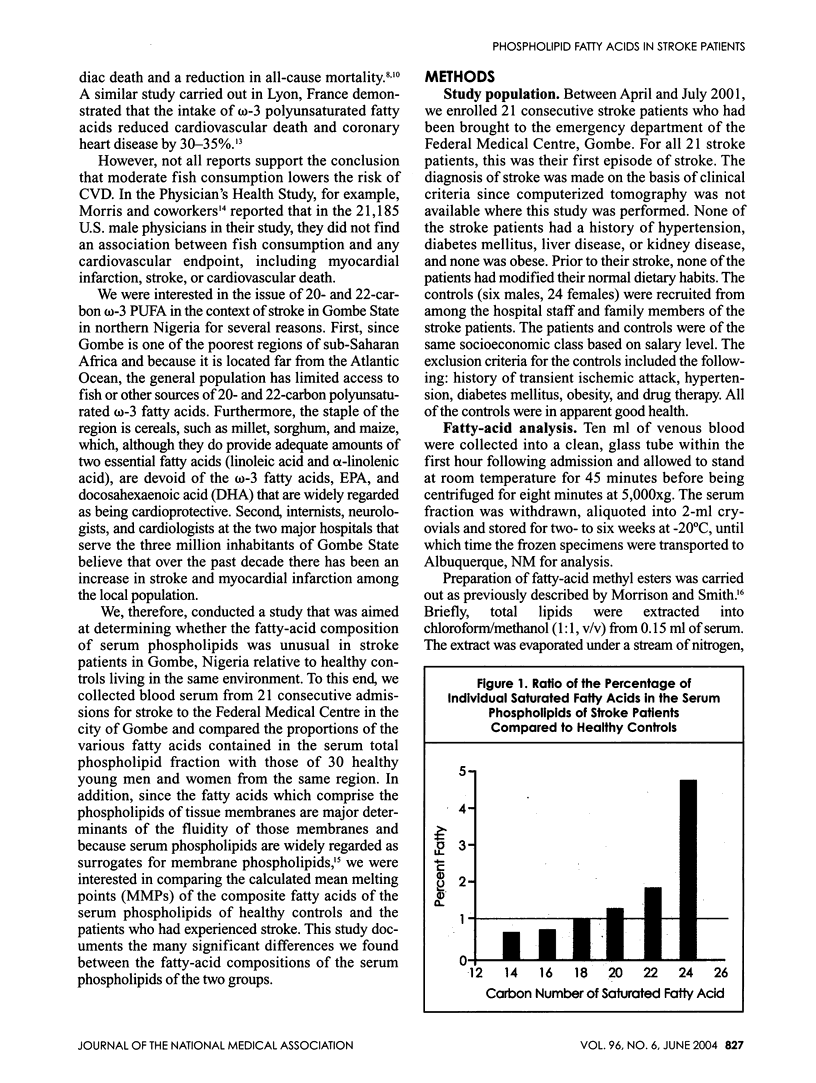
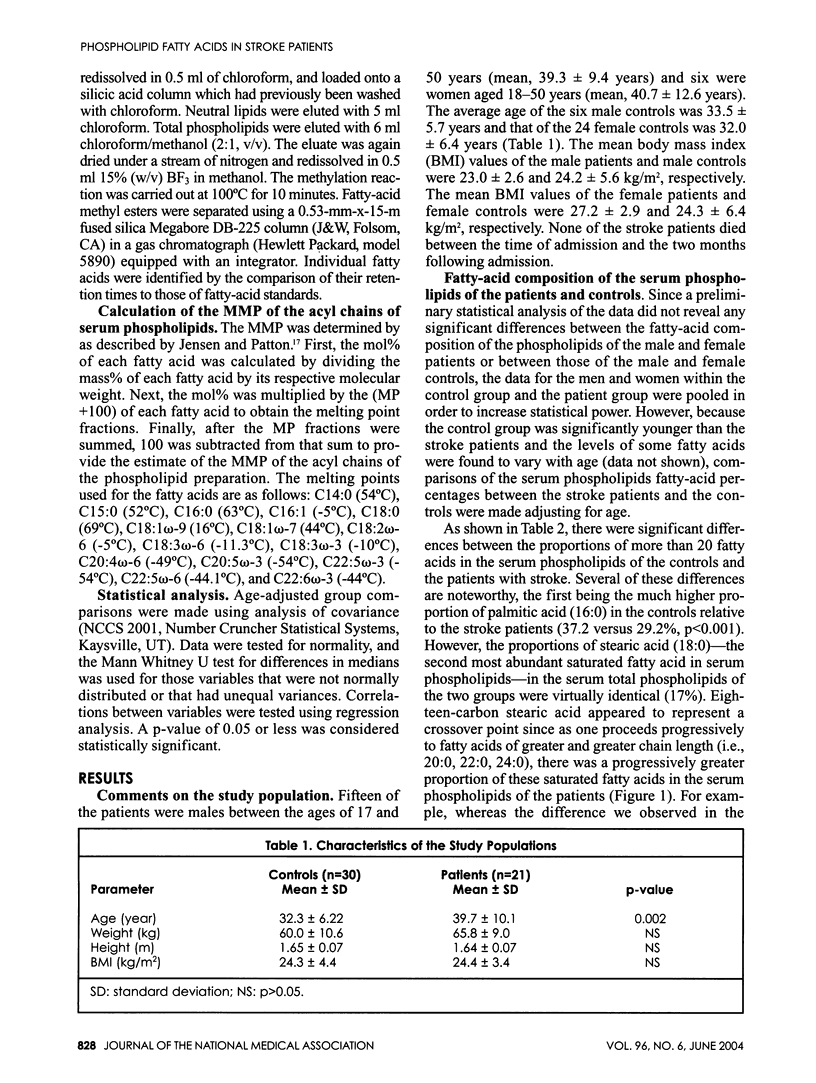
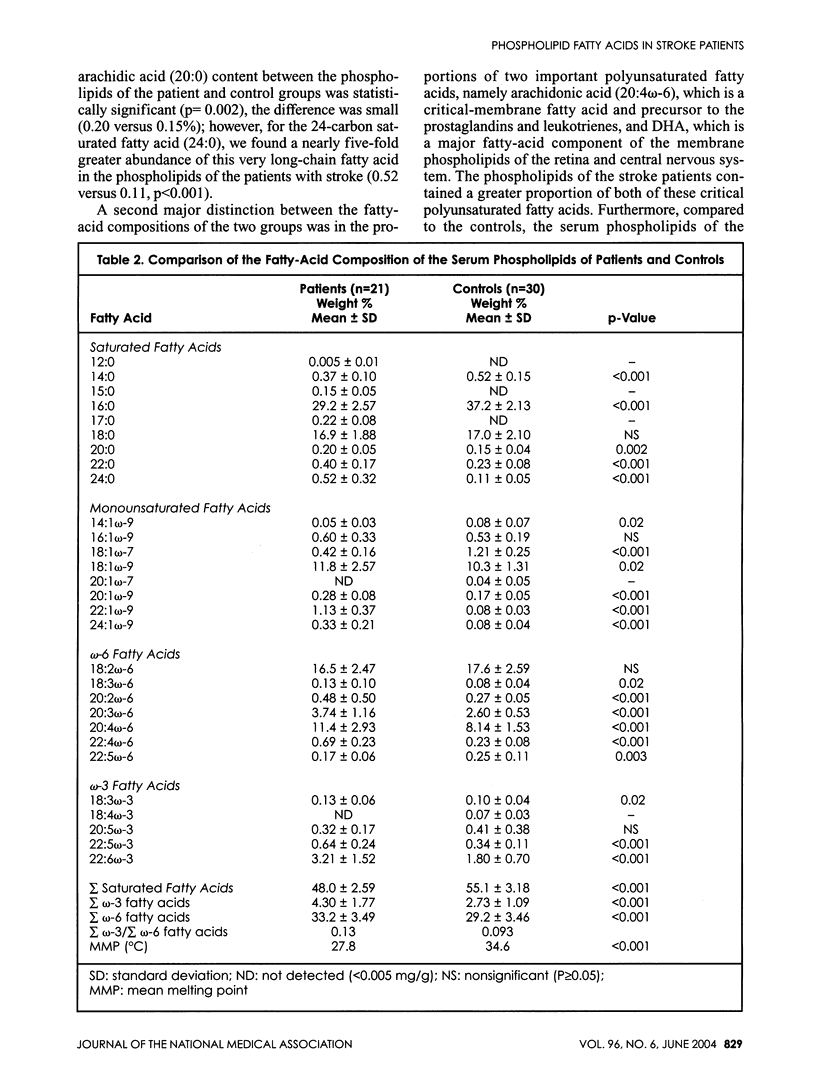
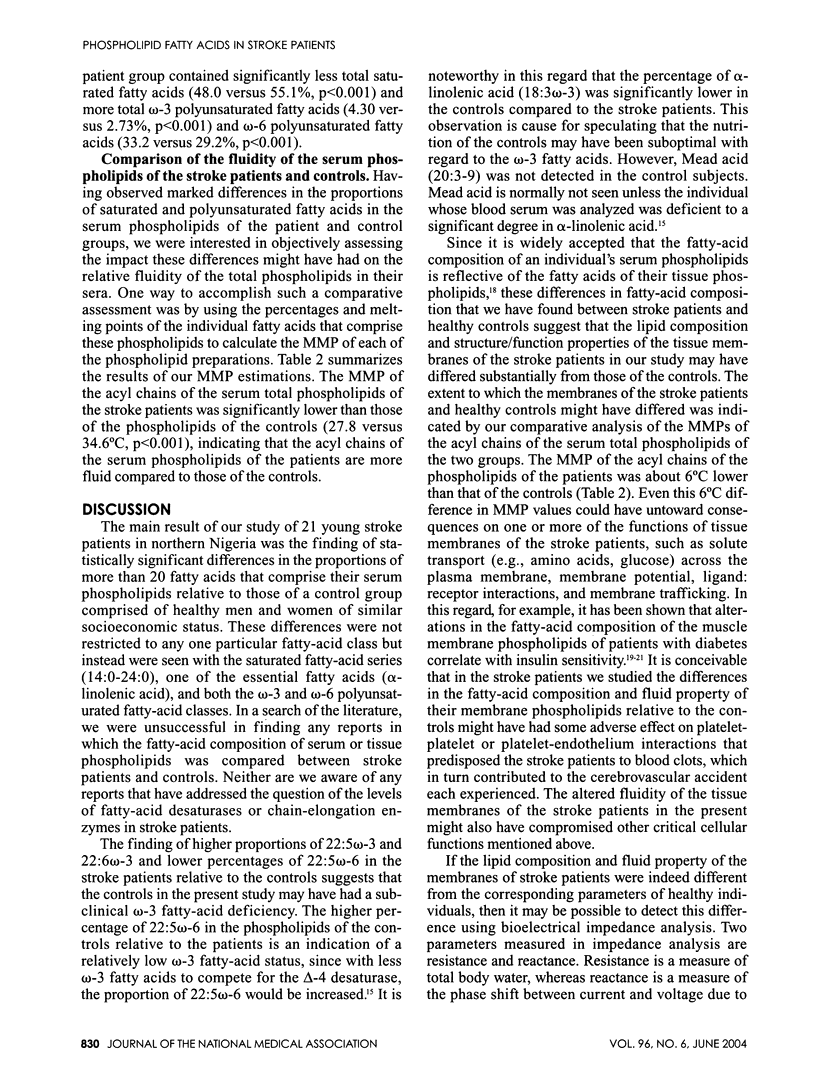
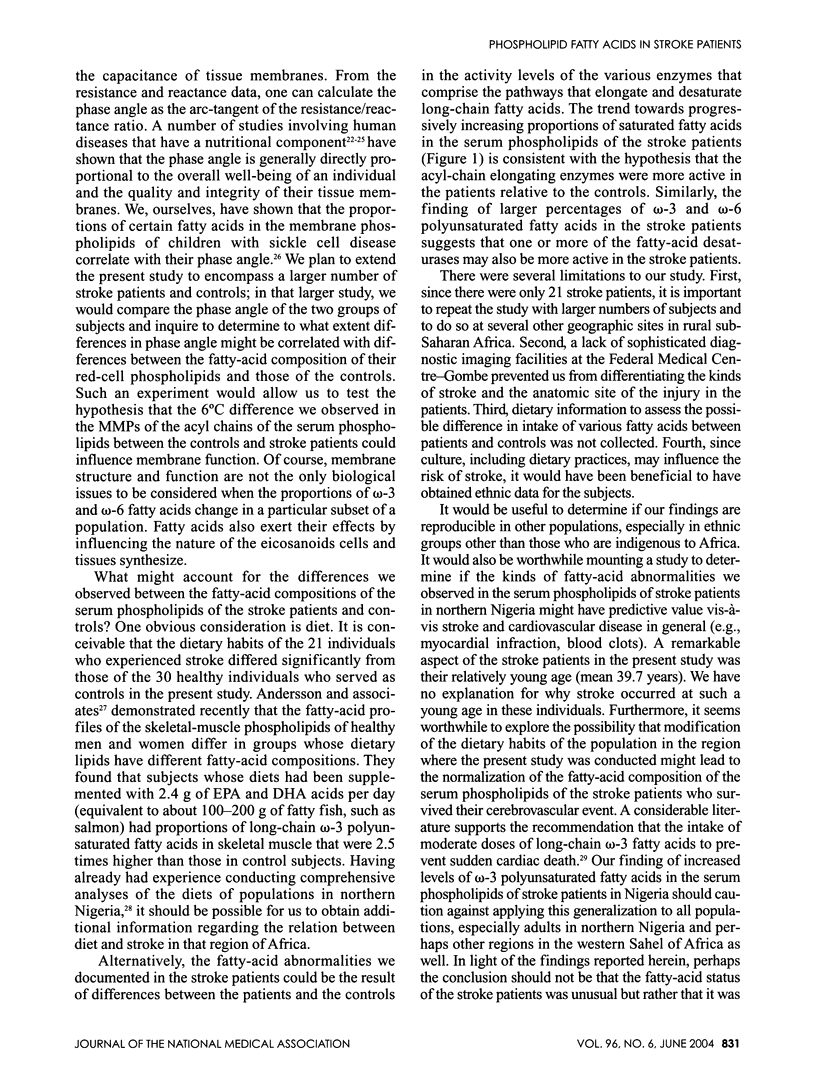
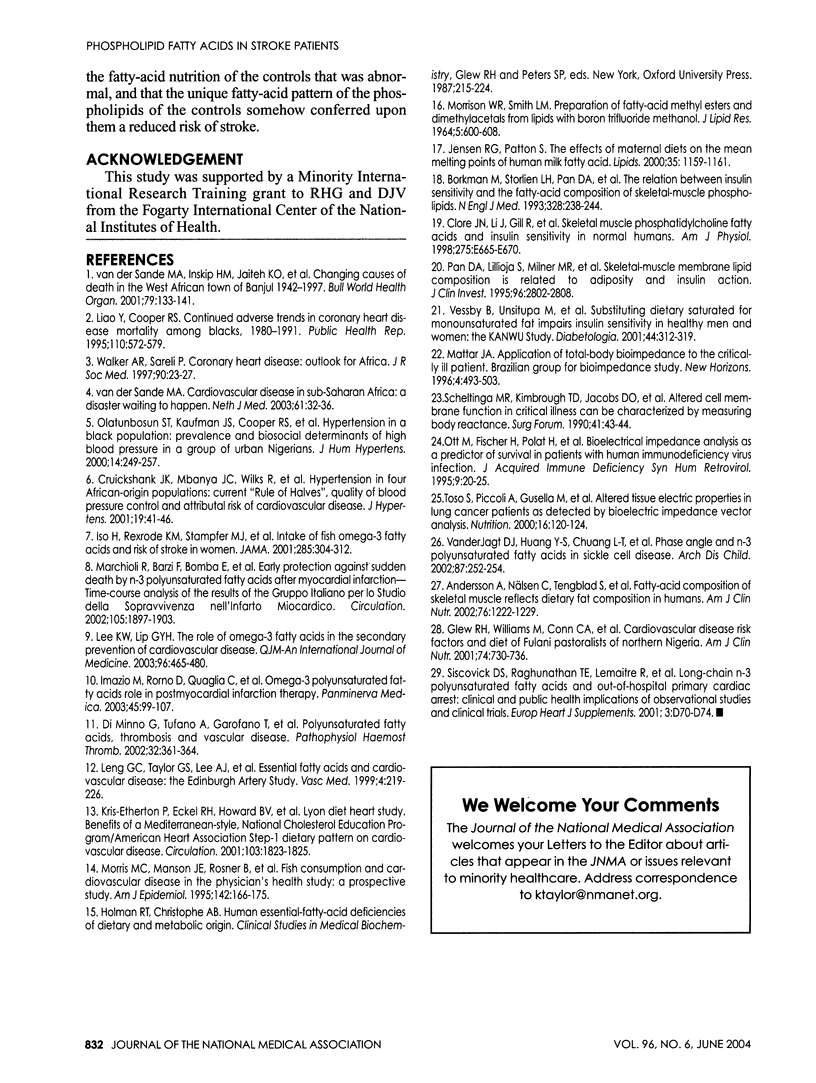
Selected References
These references are in PubMed. This may not be the complete list of references from this article.
- Andersson Agneta, Nälsén Cecilia, Tengblad Siv, Vessby Bengt. Fatty acid composition of skeletal muscle reflects dietary fat composition in humans. Am J Clin Nutr. 2002 Dec;76(6):1222–1229. doi: 10.1093/ajcn/76.6.1222. [DOI] [PubMed] [Google Scholar]
- Borkman M., Storlien L. H., Pan D. A., Jenkins A. B., Chisholm D. J., Campbell L. V. The relation between insulin sensitivity and the fatty-acid composition of skeletal-muscle phospholipids. N Engl J Med. 1993 Jan 28;328(4):238–244. doi: 10.1056/NEJM199301283280404. [DOI] [PubMed] [Google Scholar]
- Cruickshank J. K., Mbanya J. C., Wilks R., Balkau B., Forrester T., Anderson S. G., Mennen L., Forhan A., Riste L., McFarlane-Anderson N. Hypertension in four African-origin populations: current 'Rule of Halves', quality of blood pressure control and attributable risk of cardiovascular disease. J Hypertens. 2001 Jan;19(1):41–46. doi: 10.1097/00004872-200101000-00006. [DOI] [PubMed] [Google Scholar]
- Di Minno Giovanni, Tufano Antonella, Garofano Tiziana, Di Minno Matteo Nicola Dario. Polyunsaturated fatty acids, thrombosis and vascular disease. Pathophysiol Haemost Thromb. 2002 Sep-Dec;32(5-6):361–364. doi: 10.1159/000073601. [DOI] [PubMed] [Google Scholar]
- Glew R. H., Williams M., Conn C. A., Cadena S. M., Crossey M., Okolo S. N., VanderJagt D. J. Cardiovascular disease risk factors and diet of Fulani pastoralists of northern Nigeria. Am J Clin Nutr. 2001 Dec;74(6):730–736. doi: 10.1093/ajcn/74.6.730. [DOI] [PubMed] [Google Scholar]
- Imazio M., Forno D., Quaglia C., Trinchero R. Omega-3 polyunsatured fatty acids role in postmyocardial infarction therapy. Panminerva Med. 2003 Jun;45(2):99–107. [PubMed] [Google Scholar]
- Iso H., Rexrode K. M., Stampfer M. J., Manson J. E., Colditz G. A., Speizer F. E., Hennekens C. H., Willett W. C. Intake of fish and omega-3 fatty acids and risk of stroke in women. JAMA. 2001 Jan 17;285(3):304–312. doi: 10.1001/jama.285.3.304. [DOI] [PubMed] [Google Scholar]
- Jensen R. G., Patton S. The effect of maternal diets on the mean melting points of human milk fatty acid. Lipids. 2000 Oct;35(10):1159–1161. doi: 10.1007/s11745-000-0632-9. [DOI] [PubMed] [Google Scholar]
- Kris-Etherton P., Eckel R. H., Howard B. V., St Jeor S., Bazzarre T. L., Nutrition Committee Population Science Committee and Clinical Science Committee of the American Heart Association AHA Science Advisory: Lyon Diet Heart Study. Benefits of a Mediterranean-style, National Cholesterol Education Program/American Heart Association Step I Dietary Pattern on Cardiovascular Disease. Circulation. 2001 Apr 3;103(13):1823–1825. doi: 10.1161/01.cir.103.13.1823. [DOI] [PubMed] [Google Scholar]
- Lee K. W., Lip G. Y. H. The role of omega-3 fatty acids in the secondary prevention of cardiovascular disease. QJM. 2003 Jul;96(7):465–480. doi: 10.1093/qjmed/hcg092. [DOI] [PubMed] [Google Scholar]
- Leng G. C., Taylor G. S., Lee A. J., Fowkes F. G., Horrobin D. Essential fatty acids and cardiovascular disease: the Edinburgh Artery Study. Vasc Med. 1999;4(4):219–226. doi: 10.1177/1358836X9900400403. [DOI] [PubMed] [Google Scholar]
- Liao Y., Cooper R. S. Continued adverse trends in coronary heart disease mortality among blacks, 1980-91. Public Health Rep. 1995 Sep-Oct;110(5):572–572. [PMC free article] [PubMed] [Google Scholar]
- Marchioli Roberto, Barzi Federica, Bomba Elena, Chieffo Carmine, Di Gregorio Domenico, Di Mascio Rocco, Franzosi Maria Grazia, Geraci Enrico, Levantesi Giacomo, Maggioni Aldo Pietro. Early protection against sudden death by n-3 polyunsaturated fatty acids after myocardial infarction: time-course analysis of the results of the Gruppo Italiano per lo Studio della Sopravvivenza nell'Infarto Miocardico (GISSI)-Prevenzione. Circulation. 2002 Apr 23;105(16):1897–1903. doi: 10.1161/01.cir.0000014682.14181.f2. [DOI] [PubMed] [Google Scholar]
- Máttar J. A. Application of total body bioimpedance to the critically ill patient. Brazilian Group for Bioimpedance Study. New Horiz. 1996 Nov;4(4):493–503. [PubMed] [Google Scholar]
- Olatunbosun S. T., Kaufman J. S., Cooper R. S., Bella A. F. Hypertension in a black population: prevalence and biosocial determinants of high blood pressure in a group of urban Nigerians. J Hum Hypertens. 2000 Apr;14(4):249–257. doi: 10.1038/sj.jhh.1000975. [DOI] [PubMed] [Google Scholar]
- Ott M., Fischer H., Polat H., Helm E. B., Frenz M., Caspary W. F., Lembcke B. Bioelectrical impedance analysis as a predictor of survival in patients with human immunodeficiency virus infection. J Acquir Immune Defic Syndr Hum Retrovirol. 1995 May 1;9(1):20–25. [PubMed] [Google Scholar]
- Pan D. A., Lillioja S., Milner M. R., Kriketos A. D., Baur L. A., Bogardus C., Storlien L. H. Skeletal muscle membrane lipid composition is related to adiposity and insulin action. J Clin Invest. 1995 Dec;96(6):2802–2808. doi: 10.1172/JCI118350. [DOI] [PMC free article] [PubMed] [Google Scholar]
- Toso S., Piccoli A., Gusella M., Menon D., Bononi A., Crepaldi G., Ferrazzi E. Altered tissue electric properties in lung cancer patients as detected by bioelectric impedance vector analysis. Nutrition. 2000 Feb;16(2):120–124. doi: 10.1016/s0899-9007(99)00230-0. [DOI] [PubMed] [Google Scholar]
- VanderJagt D. J., Huang Y-S, Chuang L-T, Bonnett C., Glew R. H. Phase angle and n-3 polyunsaturated fatty acids in sickle cell disease. Arch Dis Child. 2002 Sep;87(3):252–254. doi: 10.1136/adc.87.3.252. [DOI] [PMC free article] [PubMed] [Google Scholar]
- Vessby B., Uusitupa M., Hermansen K., Riccardi G., Rivellese A. A., Tapsell L. C., Nälsén C., Berglund L., Louheranta A., Rasmussen B. M. Substituting dietary saturated for monounsaturated fat impairs insulin sensitivity in healthy men and women: The KANWU Study. Diabetologia. 2001 Mar;44(3):312–319. doi: 10.1007/s001250051620. [DOI] [PubMed] [Google Scholar]
- Walker A. R., Sareli P. Coronary heart disease: outlook for Africa. J R Soc Med. 1997 Jan;90(1):23–27. doi: 10.1177/014107689709000108. [DOI] [PMC free article] [PubMed] [Google Scholar]
- van der Sande M. A. B. Cardiovascular disease in sub-Saharan Africa: a disaster waiting to happen. Neth J Med. 2003 Feb;61(2):32–36. [PubMed] [Google Scholar]
- van der Sande M. A., Inskip H. M., Jaiteh K. O., Maine N. P., Walraven G. E., Hall A. J., McAdam K. P. Changing causes of death in the West African town of Banjul, 1942-97. Bull World Health Organ. 2001;79(2):133–141. [PMC free article] [PubMed] [Google Scholar]


